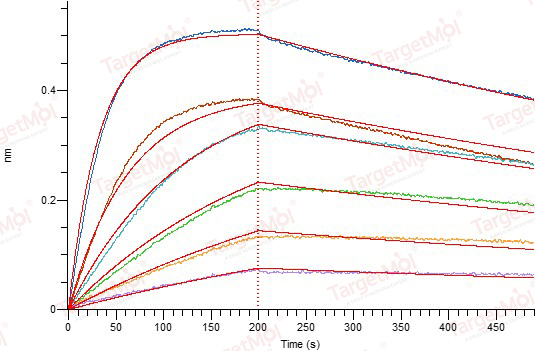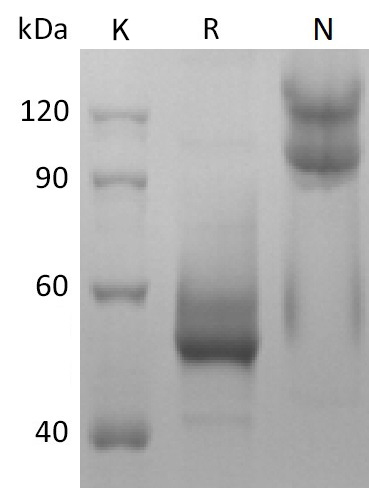Shopping Cart
Remove All Your shopping cart is currently empty
Your shopping cart is currently empty
BAFF/TNFSF13B Protein, Mouse, Recombinant (mFc) is expressed in HEK293 mammalian cells with N-mFc tag. The predicted molecular weight is 45-60 KDa and the accession number is Q9WU72.

| Pack Size | Price | USA Warehouse | Global Warehouse | Quantity |
|---|---|---|---|---|
| 5 μg | $37 | - | In Stock | |
| 10 μg | $56 | In Stock | In Stock | |
| 20 μg | $88 | - | In Stock | |
| 50 μg | $169 | - | In Stock | |
| 100 μg | $313 | 7-10 days | 7-10 days | |
| 200 μg | $589 | 7-10 days | 7-10 days | |
| 500 μg | $1,380 | 7-10 days | 7-10 days |
| Biological Activity | Loaded Human BCMA-His on HIS1K Biosensor, can bind Mouse BAFF-mFc with an affinity constant of 1.58 nM as determined in BLI assay. (Regularly tested)  |
| Description | BAFF/TNFSF13B Protein, Mouse, Recombinant (mFc) is expressed in HEK293 mammalian cells with N-mFc tag. The predicted molecular weight is 45-60 KDa and the accession number is Q9WU72. |
| Species | Mouse |
| Expression System | HEK293 Cells |
| Tag | N-mFc |
| Accession Number | Q9WU72 |
| Synonyms | Tumor necrosis factor ligand superfamily member 13B,TNF- and APOL-related leukocyte expressed ligand 1,TALL-1,Dendritic cell-derived TNF-like molecule,BLyS,B-cell-activating factor,BAFF,B lymphocyte stimulator |
| Amino Acid | Ala127-Leu309 |
| Construction | Ala127-Leu309 |
| Protein Purity | Greater than 95% as determined by reducing SDS-PAGE. (QC verified)  |
| Molecular Weight | 45-60 KDa (reducing condition) |
| Endotoxin | < 0.1 ng/µg (1 EU/µg) as determined by LAL test. |
| Formulation | Lyophilized from a solution filtered through a 0.22 μm filter, containing PBS, pH 7.4. |
| Reconstitution | Reconstitute the lyophilized protein in distilled water. The product concentration should not be less than 100 μg/ml. Before opening, centrifuge the tube to collect powder at the bottom. After adding the reconstitution buffer, avoid vortexing or pipetting for mixing. |
| Stability & Storage | Lyophilized powders can be stably stored for over 12 months, while liquid products can be stored for 6-12 months at -80°C. For reconstituted protein solutions, the solution can be stored at -20°C to -80°C for at least 3 months. Please avoid multiple freeze-thaw cycles and store products in aliquots. |
| Shipping | In general, Lyophilized powders are shipping with blue ice. Solutions are shipping with dry ice. |
| Research Background | TNFSF13B/TNFSF20 belongs to the tumor necrosis factor family. It abundantly is expressed in peripheral blood Leukocytes and is specifically expressed in monocytes and macrophages. Also found in the spleen, lymph node, bone marrow, T-cells and dendritic cells. A lower expression seen in placenta, heart, lung, fetal liver, thymus, and pancreas. Isoform 2 is expressed in many myeloid cell lines. Cytokine that binds to TNFRSF13B/TACI and TNFRSF17/BCMA. TNFSF13/APRIL binds to the same 2 receptors. Together, they form a 2 ligands -2 receptors pathway involved in the stimulation of B- and T-cell function and the regulation of humoral immunity. A third B-cell specific BAFF-receptor (BAFFR/BR3) promotes the survival of mature B-cells and the B-cell response. Isoform 2 seems to inhibit isoform 1 secretion and bioactivity. Isoform 3 acts as a transcription factor for its own parent gene, in association with NF-kappa-B p50 subunit, at least in autoimmune and proliferative B-cell diseases. The presence of Delta4BAFF is essential for soluble BAFF release by IFNG/IFN-gamma-stimulated monocytes and for B-cell survival. It can directly or indirectly regulate the differential expression of a large number of genes involved in the innate immune response and the regulation of apoptosis. Isoform 2 heteromultimerizes with isoform 1, probably limiting the amount of functional isoform 1 on the cell surface. Isoform 3 is unlikely form trimers or bind to BAFF receptors. Mature human BAFF consists of a 46 amino acid (aa) cytoplasmic domain, a 21 aa transmembrane segment, and a 218 aa extracellular domain (ECD) with a stalk region and one TNF-like domain. Within aa 134-285 of the ECD, human BAFF shares 72% aa sequence identity with mouse BAFF. |
| Size | Quantity | Unit Price | Amount | Operation |
|---|

Copyright © 2015-2026 TargetMol Chemicals Inc. All Rights Reserved.